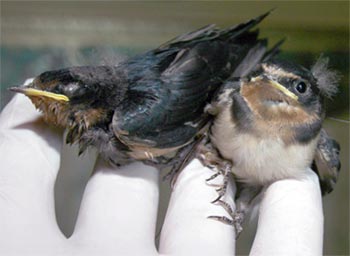Detecting conjoined twins
A pair of conjoined sparrows are causing a stir among the ornithologists. This is considered an extremely rare phenomenon, in a million cases only one.
Danny Langford in Judsonia, Arkansas, USA, found the pair on July 17 when they fell out of the nest and lay in front of his wheel. He said sparrows have been nesting near his home for the past 7 years during his annual migration to South America.
Wildlife experts say the conjoined twins are extremely rare. However, the unlucky birds stopped eating after being found and died on July 18. Researchers plan to take the two animals to the Smithsonian Institution, in Washington, DC, for further research.

(Photo: National Geographic)
Meanwhile, Gary Graves, at the Smithsonian, thinks it might not be a mutation in the gene that originated in the egg itself. X-ray images show that the bird does not share any internal organs or bone fragments as is common in consecutive twins. In addition, it was originally thought that the pair had only three legs, and later tests showed that the fourth leg was hidden under the skin that connected them.
"Maybe something happened in their team," Graves said. "A bird has a wound, and the bird got stuck in it, causing them to stick together after the wound healed."
"If so, there is no scientific problem here. It turns out to be more normal than we thought," Graves said.
- Successfully separated conjoined twins
- Successfully separated conjoined twins
- The curious life of conjoined twins 200 years ago
- Using 3D technology to recreate conjoined twins body parts
- China: Separation of conjoined twins
- Egypt: successful surgery first conjoined twins
- Indonesian boys have the most rare malformations: born with 2 faces and 2 brains
- Video: The twin fish are amazing
- Successfully separated conjoined twins
- Thailand: Successfully separated conjoined twins heart
- Amazed at the surgery to separate two conjoined girls
- True stories about twins
 Animal 'suffering' after hibernation
Animal 'suffering' after hibernation Why do goats climb well?
Why do goats climb well? Scientists were surprised to see chimpanzees eating turtles
Scientists were surprised to see chimpanzees eating turtles Giant catfish died deadly due to drought in Thailand
Giant catfish died deadly due to drought in Thailand